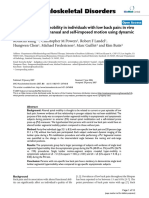Commentary On Spinal Stabilization Exercise.17
Uploaded by
Julenda CintarinovaCommentary On Spinal Stabilization Exercise.17
Uploaded by
Julenda Cintarinova15. Hudson-Cook N, Tomes-Nicholson K, Breen A. A revised Oswestry 21. Arab AM, Salavati M, Ebrahimi I, Mousavi ME.
Sensitivity,
disability questionnaire. In:Roland M, Jenner JR, eds. Back Pain: New specificity and predictive value of the clinical trunk muscle
Approaches to Rehabilitation and Education. Manchester, UK: Manch- endurance tests in low back pain. Clin Rehabil. 2007;21(7):
ester University Press; 1989:187-204. 640-647.
16. Fritz JM, Irrgang JJ. A comparison of a modified Oswestry Low Back 22. McIntosh G, Wilson L, Affleck M, Hall H. Trunk and lower extrem-
Pain Disability Questionnaire and the Quebec Back Pain Disability ity muscle endurance: normative data for adults. J Rehabil Outcomes
Scale. Phys Ther. 2001;81(2):776-788. Measure. 1998;2(4):20-39.
17. Hall AM, Maher CG, Latimer J, Ferreira ML, Costa LP. The patient- 23. Kamper SJ, Maher CG, Mackay G. Global rating of change
specific functional scale is more responsive than the Roland Morris scales: a review of strengths and weaknesses and con-
disability questionnaire when activity limitation is low. Eur Spine J. siderations for design. J Man Manip Ther. 2009;17(3):163-
2011;20(1):79-86. 170.
18. Stratford P, Gill C, Westaway M, Binkley J. Assessing disability and 24. Hicks GE, Fritz JM, Delitto A, McGill SM. Preliminary development
change on individual patients: a report of a patient specific measure. of a clinical prediction rule for determining which patients with low
Physiother Can. 1995;47(4):258-263. back pain will respond to a stabilization exercise program. Arch Phys
19. Maughan EF, Lewis JS. Outcome measures in chronic low back pain. Med Rehabil. 2005;86(9):1753-1762.
Eur Spine J. 2010;19(9):1484-1494. 25. Byström MG, Rasmussen-barr E, Johannes W, Grooten A. Motor con-
20. Andersen MO, Christensen SB, Thomsen K. Outcome at 10 years after trol exercises reduces pain and disability in chronic and recurrent low
treatment for adolescent idiopathic scoliosis. Spine (Phila Pa 1976). back pain: a meta-analysis. Spine (Phila Pa 1976). 2013;38(6):E350-
2006;31(3):350-354. E358.
CLINICAL BOTTOM LINE
Commentary on “Spinal Stabilization Exercise Effectiveness for Low Back Pain in Adolescent Idiopathic
Scoliosis: A Randomized Trial”
“How should I apply this information?”
In this study, a weekly physical therapy (PT) intervention group experienced significantly greater reduction of
pain and an improvement in patient-selected functional outcomes than an unsupervised group.
Although the use of technology, such as a DVD, is common for adolescents, using technology to provide
intervention may not be an adequate substitute for weekly contact with PT. This study provides support for
weekly PT intervention and for the role that spinal stabilization training may play in reducing low back pain in
adolescents with adolescent idiopathic scoliosis. A prevention-oriented health care system could use the results of
this study to support the development and implementation of PT programs for this patient population. The study
provides a beginning point for future research to explore spinal stabilization training for adolescents with low
back pain and the use of the Global Rating of Change, Patient Specific Functional Scale, and Revised Oswestry in
studies with adolescent subjects.
“What should I be mindful about when applying this information?”
The majority of the prescribed exercises focused on neuromuscular activation and/or hold of transverse abdo-
minis and lumbar multifidus, but change was not directly assessed for these muscle groups. The Prone Double-leg
Test is more specific to multijoint spinal extensors.
From a clinical perspective, using the Prone Double-leg Test as a test of muscular endurance should be
considered with caution. Lack of improvement may be due to factors other than endurance of the spinal extensors.
Structures that may be adversely affected during this test include spinal nerve roots due to compression during
closure of the intervertebral foramen; facet joints due to irritation from compression or hypomobility; and the
disc due to compression. Selecting an outcome measure for muscle performance requires consideration of several
factors, including (1) what one wishes to measure, for example, activation, strength, or endurance; (2) whether the
outcome measure is appropriate to assess the focus of training such as strength or endurance; and (3) how the test
may affect regional structures. Each factor has the potential to affect outcomes in a positive or negative direction.
Melodie Kondratek, PT, DScPT, OMPT
Physical Therapy Program
Oakland University
Rochester, Michigan
Dhana Ponners, PT, DPT, OMPT
The Training Room
Troy, Michigan
The authors declare no conflicts of interest.
DOI: 10.1097/PEP.0000000000000189
402 Zapata et al Pediatric Physical Therapy
Copyright © 2015 Wolters Kluwer Health, Inc. and the Section on Pediatrics of the American Physical Therapy Association.
Unauthorized reproduction of this article is prohibited.
You might also like
- Effectiveness of Core Stabilization Exercises and Routine Exercise Therapy in Management of Pain in Chronic Non-Specific Low Back Pain A Randomized Controlled Clinical Trial PDF100% (1)Effectiveness of Core Stabilization Exercises and Routine Exercise Therapy in Management of Pain in Chronic Non-Specific Low Back Pain A Randomized Controlled Clinical Trial PDF5 pages
- The Effect of Core Stabilization Exercises Using A Sling On Pain and Muscle Strength of Patients With Chronic Low Back PainNo ratings yetThe Effect of Core Stabilization Exercises Using A Sling On Pain and Muscle Strength of Patients With Chronic Low Back Pain4 pages
- Johannsen Et Al 1995 Exercises For Chronic Low Back Pain A Clinical TrialNo ratings yetJohannsen Et Al 1995 Exercises For Chronic Low Back Pain A Clinical Trial8 pages
- Chiropractic manipulation in back pain and sciatica with disc protrusionNo ratings yetChiropractic manipulation in back pain and sciatica with disc protrusion7 pages
- The Effect of Suspension and Conventional Core Stability Exercises on Characteristics of Intervertebral Disc and Chronic Pain in Office Staff Due to Lumbar Herniated DiscNo ratings yetThe Effect of Suspension and Conventional Core Stability Exercises on Characteristics of Intervertebral Disc and Chronic Pain in Office Staff Due to Lumbar Herniated Disc11 pages
- Efficacy of Mckenzie Approach Combined With Sustained Traction in Improving The Quality of Life Following Low Back Ache - A Case ReportNo ratings yetEfficacy of Mckenzie Approach Combined With Sustained Traction in Improving The Quality of Life Following Low Back Ache - A Case Report6 pages
- Efficacy of Core-Strengthening and Intensive Dynamic Back Exercises on Pain, Core Muscle Endurance, and Functional Disability in Patients with Chronic Non-Specific Low Back PainNo ratings yetEfficacy of Core-Strengthening and Intensive Dynamic Back Exercises on Pain, Core Muscle Endurance, and Functional Disability in Patients with Chronic Non-Specific Low Back Pain16 pages
- Fitness Exercises Guidelines for Patients with Spinal Deformity Based on Clinical and Radiological Risk Factors for Pain and Disability (Lise edits 1 14 25)No ratings yetFitness Exercises Guidelines for Patients with Spinal Deformity Based on Clinical and Radiological Risk Factors for Pain and Disability (Lise edits 1 14 25)3 pages
- Stretching in The Rehabilitation of LBP PatientsNo ratings yetStretching in The Rehabilitation of LBP Patients7 pages
- Effect of Physical Therapy and Visceral Osteopathic Manipulation in Lower Back Pain: A Comparative StudyNo ratings yetEffect of Physical Therapy and Visceral Osteopathic Manipulation in Lower Back Pain: A Comparative Study9 pages
- smith-et-al-2010-the-relationship-between-back-muscle-endurance-and-physical-lifestyle-and-psychological-factors-inNo ratings yetsmith-et-al-2010-the-relationship-between-back-muscle-endurance-and-physical-lifestyle-and-psychological-factors-in7 pages
- proprioceptive_neuromuscular_facilitation.6 (2)No ratings yetproprioceptive_neuromuscular_facilitation.6 (2)6 pages
- Effect of Core Stabilization Training On Endurance of Trunk Extensor and Functional Capacity in Subjects With Mechanical Low Back Pain100% (1)Effect of Core Stabilization Training On Endurance of Trunk Extensor and Functional Capacity in Subjects With Mechanical Low Back Pain8 pages
- Muscles Training For The Stability of The Spine: Invited ReviewNo ratings yetMuscles Training For The Stability of The Spine: Invited Review7 pages
- The Effectiveness of Home-Based Exercise Programs For Low Back Pain PatientsNo ratings yetThe Effectiveness of Home-Based Exercise Programs For Low Back Pain Patients4 pages
- Cervical Traction For Neck Pain Patients A Clinical Prediction Rule 1266428336No ratings yetCervical Traction For Neck Pain Patients A Clinical Prediction Rule 12664283364 pages
- Biering-Sørensen Test _ RehabMeasures DatabaseNo ratings yetBiering-Sørensen Test _ RehabMeasures Database10 pages
- Clinical Prediction Criteria For Management of LBPNo ratings yetClinical Prediction Criteria For Management of LBP36 pages
- Non-Specific Low Back Pain In Elderly And The Effects Of Myofascial Release Technique Combined With Core Stabilization Exercise: Not Just Muscles [Letter]No ratings yetNon-Specific Low Back Pain In Elderly And The Effects Of Myofascial Release Technique Combined With Core Stabilization Exercise: Not Just Muscles [Letter]2 pages
- Motor Control Exercise For Persistent, Nonspecific Low Back Pain: A Systematic ReviewNo ratings yetMotor Control Exercise For Persistent, Nonspecific Low Back Pain: A Systematic Review17 pages
- Medicine: The Effect of Lumbar Stabilization and Walking Exercises On Chronic Low Back PainNo ratings yetMedicine: The Effect of Lumbar Stabilization and Walking Exercises On Chronic Low Back Pain10 pages
- Does The Addition of Manual Therapy Approach To A Cervical Exercise Program Improve Clinical Outcomes For Patients With Chronic Neck Pain in Short - and Mid-Term? A Randomized Controlled Trial - PMCNo ratings yetDoes The Addition of Manual Therapy Approach To A Cervical Exercise Program Improve Clinical Outcomes For Patients With Chronic Neck Pain in Short - and Mid-Term? A Randomized Controlled Trial - PMC26 pages
- Stabilization Exercise For The Management of Low Back Pain PDFNo ratings yetStabilization Exercise For The Management of Low Back Pain PDF34 pages
- Core Stability Exercise Versus General Exercise For Chronic Low Back Pain-Q1No ratings yetCore Stability Exercise Versus General Exercise For Chronic Low Back Pain-Q12 pages
- 19_Mcgills_Torso_Muscular_Endurance_Test_Battery_ProtocolNo ratings yet19_Mcgills_Torso_Muscular_Endurance_Test_Battery_Protocol3 pages
- International Journal of Diabetes ResearchNo ratings yetInternational Journal of Diabetes Research6 pages
- Rehabilitation After Lumbar Spine Fusion: Development of An Exercise ProgramNo ratings yetRehabilitation After Lumbar Spine Fusion: Development of An Exercise Program120 pages
- The Effectiveness of Pre-Operative Deep BreathingNo ratings yetThe Effectiveness of Pre-Operative Deep Breathing5 pages
- Analysis of Balance Dysfuntion and Fall PDFNo ratings yetAnalysis of Balance Dysfuntion and Fall PDF6 pages
- Shyam D. Ganvir Shyam D. Ganvir, B.R. Zambare, D.B. Naikwade, D.B. NaikwadeNo ratings yetShyam D. Ganvir Shyam D. Ganvir, B.R. Zambare, D.B. Naikwade, D.B. Naikwade6 pages
- Physical Therapy Feb 2006 86, 2 Proquest Nursing & Allied Health SourceNo ratings yetPhysical Therapy Feb 2006 86, 2 Proquest Nursing & Allied Health Source9 pages
- SKF - 10000 EN - Page(s) 0536 To 0565 - Self-Aligning Ball BearingsNo ratings yetSKF - 10000 EN - Page(s) 0536 To 0565 - Self-Aligning Ball Bearings30 pages
- Basic Chemicals, Cosmetics and Dyes Export Promotion Council PDFNo ratings yetBasic Chemicals, Cosmetics and Dyes Export Promotion Council PDF45 pages
- (Oxford Specialist Handbooks) Nicholas Torpey, Nadeem E Moghal, Evelyn Watson, David Talbot - Renal Transplantation (2010, Oxford University Press)No ratings yet(Oxford Specialist Handbooks) Nicholas Torpey, Nadeem E Moghal, Evelyn Watson, David Talbot - Renal Transplantation (2010, Oxford University Press)439 pages
- MY THOUGHTS ABOUT "A Beautiful Mind": Daro, Farhannah T. Bsn-3No ratings yetMY THOUGHTS ABOUT "A Beautiful Mind": Daro, Farhannah T. Bsn-31 page
- 908 - B.Sc. Naturopathy and Yogic Science (Semester I & II)No ratings yet908 - B.Sc. Naturopathy and Yogic Science (Semester I & II)21 pages
- Audit Question List Global Requirements - Medical100% (2)Audit Question List Global Requirements - Medical23 pages
- Tinjauan Pemanfaatan Sludge Cake Pabrik Pulp Kraft Sebagai Energi Alternatif Melalui Proses GasifikasiNo ratings yetTinjauan Pemanfaatan Sludge Cake Pabrik Pulp Kraft Sebagai Energi Alternatif Melalui Proses Gasifikasi14 pages
- EW2002 AP 0610 Web - SVI2Ap With Remote SensorNo ratings yetEW2002 AP 0610 Web - SVI2Ap With Remote Sensor160 pages
- Handbook: For International Students at ETH ZurichNo ratings yetHandbook: For International Students at ETH Zurich72 pages
- Toronto FUN Guide Spring / Summer 2009 (Swimming, Etobicoke District)100% (1)Toronto FUN Guide Spring / Summer 2009 (Swimming, Etobicoke District)41 pages
- (EnvironmentAL Engineering Laboratory Manual PDFNo ratings yet(EnvironmentAL Engineering Laboratory Manual PDF93 pages







































































































